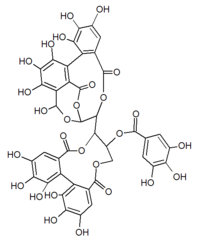Casuarinin facts for kids
Quick facts for kids Casuarinin |
|
|---|---|
 |
|
| Other names | Stachyurin |
| Identifiers | |
| CAS number | |
| PubChem | |
| SMILES | C1C(C(OC(=O)C2=CC(=C(C(=C2C3=C(C(=C(C=C3C(=O)O1)O)O)O)O)O)O)C4C5C(C6=C(C(=C(C(=C6C(=O)O5)C7=C(C(=C(C=C7C(=O)O4)O)O)O)O)O)O)O)OC(=O)C8=CC(=C(C(=C8)O)O)O |
|
InChI
InChI=1S/C41H28O26/c42-11-1-7(2-12(43)23(11)47)37(58)64-16-6-63-38(59)8-3-13(44)24(48)27(51)17(8)18-9(4-14(45)25(49)28(18)52)39(60)65-34(16)36-35-32(56)22-21(41(62)66-35)20(30(54)33(57)31(22)55)19-10(40(61)67-36)5-15(46)26(50)29(19)53/h1-5,16,32,34-36,42-57H,6H2
|
|
| Properties | |
| Molecular formula | C41H28O26 |
| Molar mass | 936.64 g/mol |
| Except where noted otherwise, data are given for materials in their standard state (at 25 °C, 100 kPa) | |
Casuarinin is an ellagitannin. It is found in the pericarp of pomegranates (Punica granatum). It is also found in Casuarina and Stachyurus species and in Alnus sieboldiana.
It is an isomer of casuarictin. It is a highly active carbonic anhydrase inhibitor.
Biosynthesis
In some plants including oak and chestnut, the ellagitannins are formed from 1,2,3,4,6-pentagalloyl-glucose and further elaborated via oxidative dehydrogenation (tellimagrandin II and casuarictin formations). After conversion of casuarictin to pedunculagin, the pyranose ring of the glucose opens and the family of compounds including casuariin, casuarinin, castalagin, and castlin, vescalagin and vescalin forms.
See also
 In Spanish: Casuariina para niños
In Spanish: Casuariina para niños

All content from Kiddle encyclopedia articles (including the article images and facts) can be freely used under Attribution-ShareAlike license, unless stated otherwise. Cite this article:
Casuarinin Facts for Kids. Kiddle Encyclopedia.
